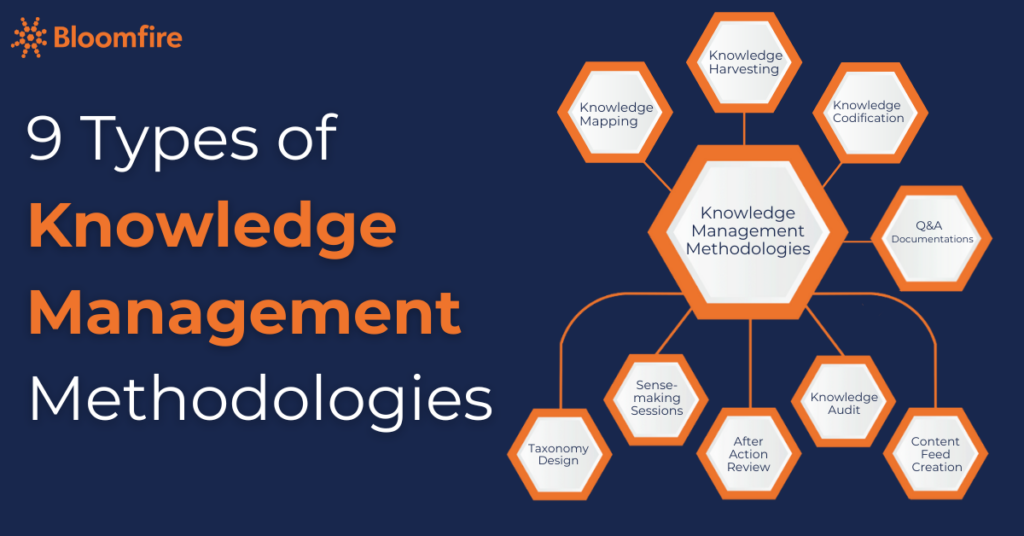9 Types of Knowledge Management Methodologies

Building a robust knowledge management (KM) system is more than just creating a company wiki or shared drive. Without the right approach, knowledge becomes fragmented, inaccessible, and ultimately, a lost opportunity. Fortunately, various knowledge management methodologies can address these challenges head-on, which include knowledge mapping, harvesting, codification, audit, content feed creation, etc.
Learn more about these modern knowledge management approaches when establishing or elevating your KM system. Don’t miss how each can positively influence your business’ success.

1. Knowledge Mapping
Knowledge mapping visually shows what knowledge exists within your organization and how it flows between different groups. It can take many forms, like diagrams, concept maps, or even interactive software, but the goal is always the same: to track and manage knowledge, making it more accessible and understandable.
You can use knowledge maps to inventory the knowledge within different teams or repositories across your company. This is one of the knowledge management methodologies that may be especially helpful if you migrate assets from various sources to one central location.
Creating a knowledge map typically involves identifying and breaking key knowledge domains into smaller topics and subtopics. Then, you link these topics to show their relationships and dependencies, often adding resources, experts, and other relevant information to the map.
Tame Your Knowledge Chaos
Map and design a knowledge taxonomy in Bloomfire that makes finding information a breeze.
Explore Bloomfire
2. Knowledge Harvesting
Knowledge harvesting is a method for capturing and transferring the knowledge employees have gained from experience (tacit knowledge). It involves gathering information and insights from subject matter experts (SMEs), typically through structured interviews and recording. and then sharing that knowledge so that the rest of the organization benefits from it.
In many organizations, knowledge harvesting occurs when an employee prepares to leave the company. However, more mature knowledge-centric businesses increasingly recognize the value of conducting knowledge-harvesting exercises proactively. These companies may harvest knowledge continuously by building an internal Q&A database or setting aside time for SMEs to record video interviews or training sessions.
3. Knowledge Codification
While knowledge harvesting focuses on extracting knowledge from experts and storing it, knowledge codification goes a step further by actively organizing and structuring this knowledge for easier retrieval and application. This approach makes knowledge more accessible, promotes reuse, and facilitates knowledge transfer across the organization.
As this knowledge management methodology involves converting and organizing tacit knowledge into explicit knowledge, formats like documents, databases, diagrams, and artificial intelligence systems are often leveraged. The key steps to codifying knowledge include sorting, cleaning, and packaging data and information for easy use.
Power Move: Knowledge codification is done seamlessly in a KM platform. With a projected market share growth from 30.1 billion USD in 2024 to 66.2 billion USD by 2032, companies are now coming to terms with the value of knowledge management software in business expansion and revenue growth. Get a dedicated knowledge management solution so you don’t miss the substantial benefits of KM systems and get left behind by your competitors.
4. Knowledge Audit
A knowledge audit aims to understand what knowledge exists, who possesses it, how it’s used, and where gaps or redundancies exist. This method is one of the knowledge management approaches that involves identifying, analyzing, and evaluating an organization’s knowledge assets.
When companies audit their knowledge landscape, they can pinpoint knowledge gaps hindering innovation or efficiency, identify underutilized expertise, and eliminate redundant efforts. As a result, knowledge management champions can develop strategies to capture and preserve valuable knowledge, promote collaboration and knowledge sharing, and ensure the right information reaches the right people at the right time.
5. Taxonomy Design
Taxonomy design allows people to find knowledge assets based on specific criteria. Think about the experience of shopping for clothes online and filtering your results by product type, price range, and color. Taxonomies help you narrow down the results that matter most to you.
If your knowledge management platform allows you to configure your categories or filters, you can design categories relevant to your business and people’s work styles. For example, you might create categories for different departments, regions, or product lines so people can search for content and quickly drill down using the criteria they care about.
6. Sensemaking Sessions
Sensemaking is a collaborative session where people come together to improve their shared understanding of a topic or problem. It allows teams to bring together their different perspectives and areas of expertise so that everyone can build on their shared knowledge.
Bridget Gilbert, Director of Market Research at Gojo (and a Bloomfire customer), describes how her team uses sensemaking sessions: “We share reports in advance, and then bring stakeholders together into an interactive session to discuss implications and action items from the research. A typical session includes time for Q&A, breakout groups or individual thought exercises to engage with the insights, and convergence on key takeaways and actionable next steps.”
Power Move: if you’re hosting sensemaking sessions, record and upload the video recordings to your knowledge management platform so that people who couldn’t attend live can still benefit.
7. After Action Review (AAR)
An After-Action Review, or AAR, fosters a culture of continuous improvement by capturing valuable insights, lessons learned, and best practices that can be shared and applied to future endeavors. This is because it is a structured process used to analyze past events, typically immediate projects, activities, or critical incidents, to learn from both successes and failures.
When implementing AAR, participants are encouraged to openly share their perspectives and observations on the event, focusing on key questions like: “What was planned?”, “What actually happened?”, “Why were there differences?” and “What can we learn from this?”. The insights gathered are then documented and disseminated, often in reports, presentations, or databases, to ensure that the knowledge gained is readily available.
8. Q&A Documentation
How often do SMEs in your organization answer the same questions for different people? If the answer is “too many,” then developing a Q&A (question and answer) documentation process can help.
If you use a KM platform like Bloomfire with a built-in Q&A tool, team members can publish questions to the platform and crowdsource answers from SMEs. The questions and answers become searchable, so the next time someone else has the same query, they can find the answer in the platform rather than having to track down an SME. This also helps your organization organically grow its collection of documented expertise over time.
9. Content Feed Creation
Content feed creation involves curating and grouping content so users can consume the information most relevant to them. It provides a personalized experience similar to what people are accustomed to with commercial media products (think of the highly specific feeds on your Netflix account or product recommendation lists on Amazon). It also helps reduce information overload, improve content engagement, and connect people to the information they need faster.
You can streamline content feed creation by using a platform like Bloomfire that allows you to configure content feeds based on specific criteria. You can even set them up to meet the needs of different demographics or situations. For example, you might create an onboarding feed that pulls in all relevant materials for new hires, or you might make a product news feed that gathers all updates shared by members of your product team.
How to Implement New Knowledge Management Methodologies
No matter what approach you take to knowledge management, it’s crucial to develop a plan to implement and eventually evaluate the success of your methodologies. In fact, it is optimal to tie your identified methods with your knowledge management strategies. Here are six essential steps to consider for successfully implementing new KM approaches.
- Assess your organization’s current knowledge management needs. You’ll want to choose the methodologies that best address your top knowledge management priorities. For example, if you’re kicking off an initiative to centralize content living in different departments, start with knowledge mapping. If many of your most tenured employees will retire in the next few years, you might prioritize knowledge harvesting to preserve their expertise.
- Develop a plan to implement and monitor the chosen methodologies. Document your plan and define clear ownership of all action items so the initiative doesn’t fizzle out. Monitor your methodologies in various ways (e.g., employee surveys or content engagement metrics in your knowledge management platform).
- Establish objectives and key results (OKRs). Establish clear objectives for your initiative and determine how you will measure success. If you’re using Q&A documentation, you might aim to maintain a certain percentage of questions with approved answers in your knowledge management platform.
- Train employees on new processes. Any knowledge management methods you choose will likely require employees to get used to new processes for knowledge documentation or sharing. Communicate expectations for these new processes and provide training so employees can be successful.
- Evaluate and modify existing processes as needed. Continue tracking your OKRs to determine the success of your chosen methodologies. If you’re falling behind your goals, locate where you can make incremental changes.
Power Move: Knowledge management methodologies are as ever-evolving as any organization’s living systems. To complement your approach, stay on top of knowledge management trends to help your company maximize the benefits of reliable KM software and its supplementary tools. You can also experiment with different methodologies over time or develop your processes to fit your business.
Knowledge Management Methods in a Nutshell
As you think about implementing or improving your organization’s knowledge management program, remember that there’s no one right methodology–and you can combine multiple methods to capture and share knowledge in different formats. What’s most important is figuring out which approaches are most effective for your business–and which makes it as easy as possible for people to document, share, and find knowledge.
Note: This blog post was originally published on February 17, 2023. It was most recently expanded and updated in January 2025.
Boost KM with Bloomfire
Effortlessly implement knowledge management methodologies with a powerful and intuitive platform.
Schedule a Demo

How to Improve Customer Service in Call Centers: 21 Ways to Enhance Contact Center Experience

Innovative Ways Companies Are Using Knowledge Management

How to Implement a Knowledge Check in 6 Steps

Estimate the Value of Your Knowledge Assets
Use this calculator to see how enterprise intelligence can impact your bottom line. Choose areas of focus, and see tailored calculations that will give you a tangible ROI.

Take a self guided Tour
See Bloomfire in action across several potential configurations. Imagine the potential of your team when they stop searching and start finding critical knowledge.